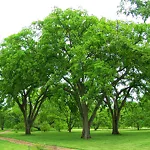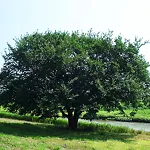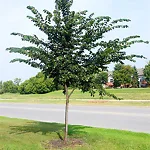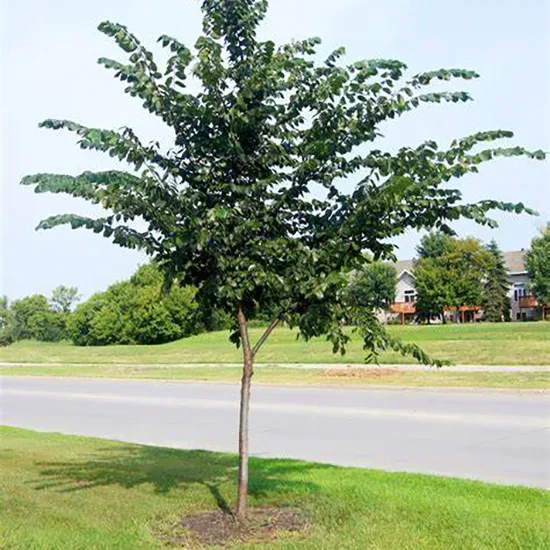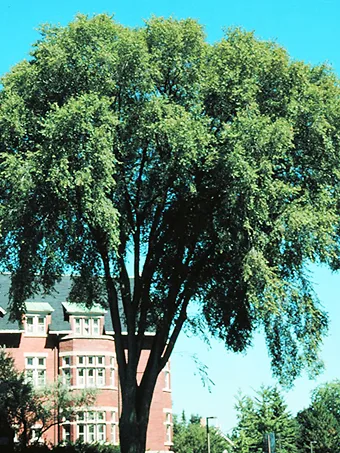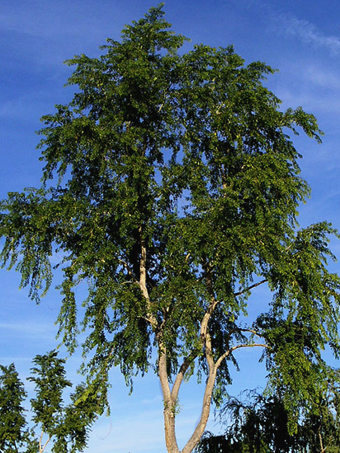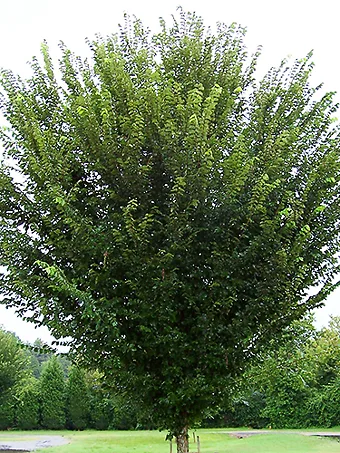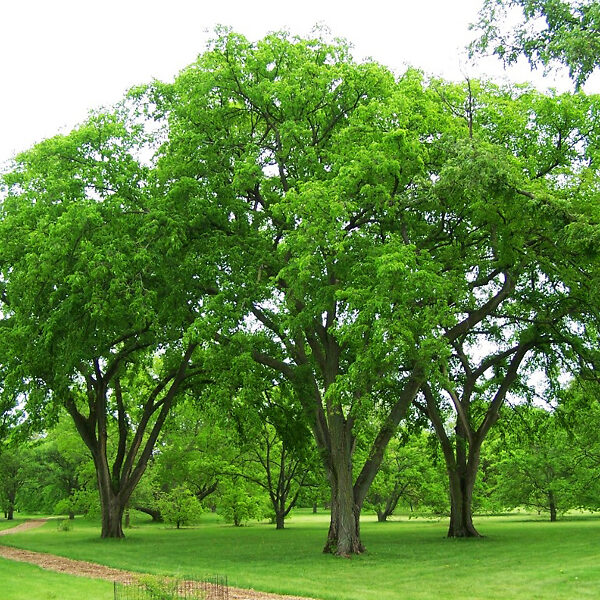
Prairie Expedition® Elm Tree
Ulmus americana 'Lewis & Clark'View more from Elm Trees
Prairie Expedition® Elm Tree
Ulmus americana 'Lewis & Clark'
30 day - ARRIVE AND THRIVE™ guaranteeLearn more


Special Features

Botanical Name
Ulmus americana 'Lewis & Clark'
Outdoor Growing zone
3-9
Mature Height
55-60
Mature Width
35-40
Sun needs
Full Sun
The Prairie Expedition® Elm Tree is a variety of the American elm tree that has high resistance to the deadly Dutch Elm Disease, and that offers hope that we can again see these magnificent trees in our gardens and streets. It grows rapidly into a tall tree with an arching, cathedral-like crown, reaching 60 feet tall and 40 feet wide when mature. It makes a classic shade tree for a lawn, an avenue or screening tree, or a splendid addition to a woodland. The lustrous dark-green leaves turn yellow in fall and the rugged trunk is a beautiful feature.
- Classic American elm – not a hybrid
- High resistance to Dutch Elm Disease
- Magnificent shade tree with cathedral-like crown
- Perfect shade tree – and fast-growing
- Thrives even in difficult locations and poor soils
Full sun is best for the Prairie Expedition® Elm Tree, which grows in almost all conditions, from cold zones to hot; dry soil to wet; sand to clay; and acid to alkaline conditions. It doesn’t suffer from pests or diseases, and although not immune, it does have high resistance to Dutch Elm Disease. Some formative pruning is helpful to create the perfect tree, but this tree is very self-sufficient, once established.
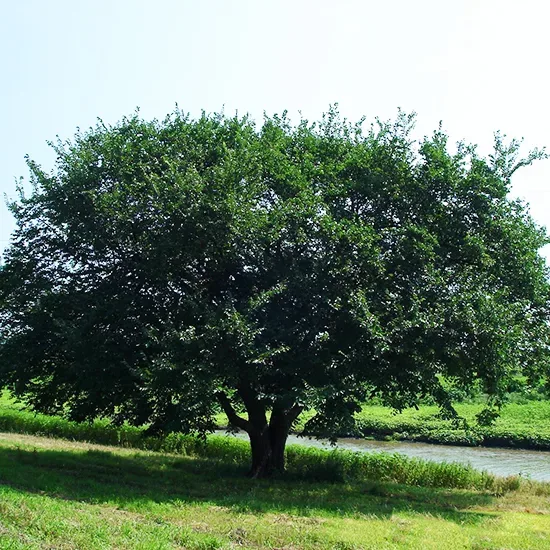
Although it has been decades since the cruel demise of the American elm tree from our towns and cities, it is still missed, like a much-loved friend who has passed on. Many people still yearn from the cathedral-like avenues of majestic trees that used to line the streets of our town – now replaced by some good trees, it is true, but nothing that matches the glory of those elms. If you didn’t already know, they were wiped out by the arrival in the 1920s of a shipment of logs from the Netherlands in New Orleans. Heading for a factory in Ohio, the train was a ‘super-spreader’ event. The logs harbored tiny beetles that carried a virulent mutation of Dutch Elm Disease. A fungal infection, that disease quickly kills trees completely, and no truly effective control has been found ever since then. As that train headed north, beetles flew from it, and quickly established in our elm trees, beginning a plague that peaked in the 1970s, and by 1990 destroyed three-quarters of the almost 80 million trees estimated to be growing across the United States.
But today we have hope again, because a very small number of trees had resistant genes, and the most outstanding one available seems to be the Prairie Expedition® Elm Tree. A true American elm, not a hybrid, this tree is a lone survivor from North Dakota, found by the State University and released in 2004 to mark the 200th anniversary of the Lewis & Clark Expedition. If you want to again have an elm in your garden, this is the tree you have been waiting for.
Growing the Prairie Expedition® Elm Tree
Size and Appearance
The Prairie Expedition® Elm Tree is a true American elm, growing 55 to 60 feet tall, with a long, unbranched trunk and an arching crown that will spread to a width of 40 feet. The branches arch out at about 45 degrees, creating the classic vase-shape that makes this tree so distinctive. It is fast-growing, and young trees can add 5 feet to their branches every year under ideal conditions, for at least the first few years. The dark-gray bark is deeply ridged and furrowed when mature, giving a noble look to this tree. The leaves are 3 to 6 inches long, and 1 to 3 inches wide, with crisp veins and a double-toothed margin. If you look closely you will see that the base of the leaf is irregular – longer on one side than the other. This is characteristic of the tree. The leaves are very handsome, slightly glossy and a rich dark green. They turn yellow in fall. Older trees will produce seeds, which are released in May. These are like thin, papery wafers, rounded, with each one carrying a single seed. They do not make a major neatness problem, soon blowing away.
Using the Prairie Expedition® Elm Tree in Your Garden
This is the greatest shade tree of them all, growing tall, so it doesn’t block windows or occupy a lot of ground space, but arching over into a broad, dense crown that will shade your whole house in summer. Plant it on a lawn, or among other existing shade trees in wooded areas. Make an avenue or boundary markers with it, spacing the trees between 10 and 40 feet apart, depending on the density you want. Be careful not to plant beneath overhead lines, or within 20 feet of a building or property line. Don’t plant near to drain or sewer pipes.
Hardiness
One reason for the popularity of the American elm is how large a part of the country it can be grown in – all the way from icy zone 3 to hot and humid zone 9 – a remarkable range.
Sun Exposure and Soil Conditions
The Prairie Expedition® Elm Tree should be planted in full sun, or in a place where the crown will soon be in the full sun. It grows best in deep, rich, well-drained soils, but another reason for its popularity is how amazingly adaptable this tree is, growing in almost every soil. It tolerates both very acidic and very alkaline soils, grows in everything from sands to clays, and in both dry and wet ground. It is incredibly adaptable, growing almost anywhere at all.
Maintenance and Pruning
Some formative pruning as it develops is worthwhile, to have the best tree possible. Keep the main trunk clean of small branches, pruning up a few each year, to avoid scarring and to leave foliage to help the vigor and growth of the tree. Thin out the crown of crowded branches, and when you see a pair of branches with a tight, narrow space between them – called a narrow crotch – remove one branch, as these are stress points where breakage under snow, ice or high winds can happen.
This tree is generally free of any significant pests or diseases. It has generally performed well in trials against Dutch Elm Disease, Ophiostoma, which is spread by 3 different species of elm bark beetles. It is widely recognized as being very resistant to this disease, although that doesn’t equal immunity. We can’t guarantee that at some point it won’t become infected, but we can tell you that it is very unlikely. The very fact that there are few elm trees around means that isolated trees have very good chances of survival.
History and Origin of the Prairie Expedition® Elm Tree
The Wild Rice River is a tributary of the famous Red River of North Dakota. It was there, near Fargo, in 1994, that horticulturists from the North Dakota State University found a group of dead elm trees. Among them was one tree still living. Pieces of the stems of that tree were taken back to the University and successfully rooted. Checks of that original tree up to 2008 found it still in perfect health. In 2004 the University released plants grown from those stem pieces, giving it the name of ‘Lewis & Clark’. To benefit the Research Foundation of the University, the tree was released with the trademark name of Prairie Expedition®.
Buying the Prairie Expedition® Elm Tree at the Tree Center
Resistant elm trees are always in high demand, and difficult to obtain. We have found some great trees, genetically identical to that first tree near Fargo, and growing on their own roots. If you love America’s elm, then order right away, but these trees will be sent to new homes very, very quickly.
